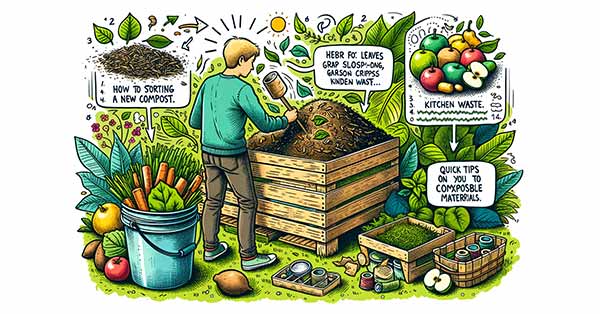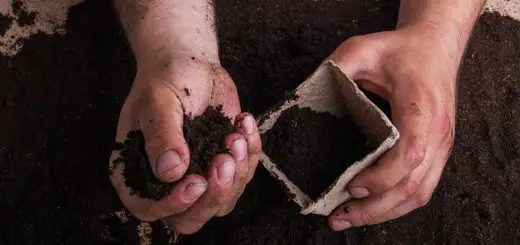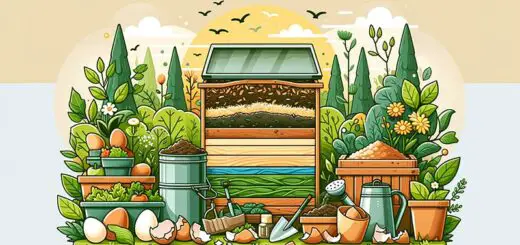Tips for Starting a Compost Pile
Compost piles transform kitchen scraps and yard waste into a nutrient-rich, natural fertilizer. At its core, all you need to do is:
- Choose a Suitable Location: A spot with good drainage and a mix of sun and shade.
- Select a Container: This can be a DIY bin, a purchased composter, or simply a heap on the ground.
- Add Organic Waste: Mix greens (like vegetable scraps) with browns (like dry leaves).
- Maintain: Keep it moist but not soggy, and turn it occasionally to allow air in.
That’s the basic gist of it! But, just like baking a cake, while the basic recipe is simple, the magic lies in the details. How do I get the perfect moisture balance? Or are you curious about those microorganisms working away in your compost?
Dive in as we delve deeper into each step, uncovering the secrets to a thriving compost pile that your garden will thank you for. Read on!
Key Takeaways from “Tips for Starting a Compost Pile”
- Composting Basics: Composting is a natural way to recycle organic waste into a rich soil enhancer. It’s eco-friendly, reducing methane emissions and decreasing landfill waste.
- Location Matters: Choose a spot with a balance of sunlight and shade, good drainage, and easy accessibility.
- Material Management: Use green (nitrogen-rich) and brown (carbon-rich) materials. Avoid meat, dairy, diseased plants, and inorganic items to prevent pests and odors.
- Setting Up the Bin: Either craft a DIY bin or purchase one that suits your needs. Ensure it’s of a decent size with adequate ventilation for airflow.
- Maintain Moisture: Keep the compost damp like a wrung-out sponge.
- Manage moisture levels, especially during heavy rains or dry periods.
- Layering Techniques: Aim for a 2:1 ratio of brown to green materials. Layering helps in maintaining a balance and ensuring efficient decomposition.
- Microorganisms’ Role: Bacteria, fungi, worms, and beetles are vital in breaking down the compost materials. Please support them by maintaining the pile’s optimal conditions.
- Aeration: Regular turning introduces oxygen, aiding in even and efficient decomposition.
- Troubleshooting: Address issues promptly, whether foul odors, pests, or slow decay.
- Harvesting Compost: Mature compost is dark, crumbly, and has an earthy smell. Incorporate it into garden beds, use it as mulch, or make a compost tea for plants.

Basics of Composting: An Introduction for Beginners
Composting, at its heart, is a natural process where organic matter breaks down, transforming into a nutrient-rich material often referred to as “black gold” by gardening enthusiasts. It’s a sustainable way to recycle organic waste, reducing the need for chemical fertilizers and decreasing the amount of trash heading to landfills.
Why is composting beneficial for the environment?
When organic waste decomposes in landfills, it often does so without access to air. This anaerobic decomposition releases methane, a greenhouse gas many times more potent than carbon dioxide. Composting, on the other hand, is an aerobic process.
Done correctly, it produces very little methane. Beyond reducing harmful gases, composting enriches the soil, improving its structure and ability to hold water and nutrients. This means healthier plants and a reduced need for chemical additives.
Choosing the Right Location for Your Compost Pile
The location of your compost pile or bin plays a crucial role in its success. Here’s what to consider:
- Sunlight: A compost pile needs a good balance of the sun and shade. While sunlight helps warm the pile and speed up the decomposition process, too much direct exposure can dry it out. Ideally, choose a location that receives dappled sunlight throughout the day.
- Drainage: Proper drainage is essential to prevent the pile from becoming too wet or waterlogged. A soggy compost pile can become anaerobic, leading to unpleasant odors and inefficient decomposition. A slightly elevated or well-draining spot is optimal.
- Convenience: Remember, you’ll be adding to this pile regularly. Positioning it too far away from your kitchen or primary source of compostable materials might make the task more cumbersome. Think about accessibility when choosing the spot.
Materials to Compost and What to Avoid
When composting, knowing what goes in and what stays out is essential.
Compostable Items (Green and Brown Materials):
- Green Materials: These are nitrogen-rich items like vegetable and fruit scraps, fresh grass clippings, coffee grounds, and eggshells. They’re the primary source of nutrients for the microorganisms that power the composting process.
- Brown Materials: Carbon-rich materials include dry leaves, twigs, paper, cardboard, and straw. They provide the necessary structure to the pile, aiding in aeration.
Non-compostable Items:
While tossing all organic waste into the compost is tempting, certain items are best avoided. These include meat scraps, dairy products, diseased plants, and inorganic materials like plastics. These can attract pests, produce foul odors, and even introduce harmful pathogens to your compost.
Steps to Set Up Your First Compost Bin
Setting up a compost bin is a pivotal step in your composting journey. While the idea might seem daunting, it’s more about choosing a method that aligns with your needs and space.
DIY Bins vs. Store-bought Options:
When it comes to containers, there’s no one-size-fits-all. Some gardening enthusiasts craft their bins using old pallets or chicken wire, relishing the DIY aspect. These homemade options can be cost-effective and tailored to fit specific spaces.
Conversely, store-bought composters come in various designs, from tumbling models to stackable units, offering ease and efficiency.
Dimensions and Airflow Considerations:
The size of your bin plays a role in how quickly materials decompose. A good rule of thumb for a starter pile is a 3-foot cube. This size captures heat efficiently, aiding decomposition without being unwieldy. Equally crucial is airflow, which helps maintain the aerobic conditions vital for composting.
Ensure that your chosen bin or pile has adequate ventilation, whether through gaps in a wooden structure, holes in a plastic container, or the inherent design of a wire enclosure.
Maintaining the Perfect Moisture Balance
Water is to compost what yeast is to bread; it activates and sustains the process. Yet, like many things in life, it’s all about balance.
Role of Rainfall and Natural Elements:
Outdoor compost piles are at the mercy of the elements. They risk becoming too wet during heavy rains, while in hot, sunny conditions, they might dry out. If your compost pile becomes too soggy, turn it more frequently, adding brown materials to absorb excess moisture.
Conversely, in dry periods, sprinkle water to maintain dampness akin to a wrung-out sponge.
Layering Techniques for Efficient Decomposition
Layering is not just a strategy for dressing in unpredictable weather; it’s also the key to an efficient compost pile.
Balancing Green and Brown Waste:
The secret sauce of composting lies in the ratio of green to brown materials. Think of it as a dance between nitrogen-rich greens and carbon-heavy browns.
A general guideline is to aim for 2 parts brown to 1 part green. This balance ensures steady decomposition while preventing foul odors.
Best Practices for Layering Materials:
Begin with a coarse, twiggy layer at the base for airflow. Add kitchen scraps and green yard waste interspersed with layers of brown materials. This maintains the carbon-nitrogen balance and ensures that the pile remains airy and less compacted. Regularly mixing or turning these layers can further enhance the decomposition rate.
Much like any skill, mastering the art of layering and moisture balance takes practice and observation. As you get familiar with the rhythms of your compost pile, tweaking these techniques becomes intuitive, leading you closer to that perfect, crumbly compost every gardener dreams of.
Understanding the Role of Microorganisms in Composting
The magic of composting is essentially thanks to a bustling community of microorganisms. These tiny, often invisible creatures are the true heroes, tirelessly working to break down organic matter into nutrient-rich compost.
How Bacteria, Fungi, and Other Tiny Critters Help:
Bacteria are the initial decomposers, attacking fresh organic matter and starting the breakdown process. As the compost heats up due to their activity, fungi, and actinomycetes take over, breaking down the tougher components like cellulose and lignin.
Throughout this process, larger organisms like worms, beetles, and mites play their part, further decomposing and aerating the pile.
Understanding these microorganisms’ roles deepens our appreciation for nature’s intricate processes and informs our composting practices. We support these microscopic workers by maintaining optimal conditions ensuring efficient and swift compost production.
How to Turn and Aerate Your Compost
Oxygen is a vital ingredient for successful composting. It ensures the process remains aerobic, producing a sweet-smelling, fertile end product.
Tools and Techniques:
While nature does its part, some manual intervention can boost the process. Turning the compost pile using garden forks, shovels, or specialized aerating tools introduces fresh oxygen, ensuring even decomposition.
How often you turn depends on your pile’s size and type. Some gardeners turn their compost every week for faster results, while others do it monthly.
Troubleshooting Common Compost Problems
Despite best efforts, compost piles sometimes encounter issues. Recognizing and addressing them promptly can save a lot of time and effort.
Odors, Pests, and Slow Decomposition:
- Foul Odors: A rotten smell usually indicates anaerobic conditions. This can be rectified by turning the compost, adding brown materials, and ensuring proper drainage.
- Pests: Flies and rodents might be attracted to certain materials. Ensuring you don’t add meat or dairy, burying fresh additions under brown waste, and using a bin with a tight-fitting lid can help.
- Slow Decomposition: If the pile is taking its time, consider adding more green materials, ensuring it’s moist enough, or increasing the turning frequency.
Using Your Finished Compost: Enriching Your Garden Naturally
After weeks or months of anticipation, the moment arrives when your compost is dark, crumbly, and ready to nourish plants.
Harvesting and Utilizing:
Determining compost maturity is a mix of observation and art. Mature compost is dark brown, with an earthy odor and a crumbly texture. When you believe it’s ready, sieve out any large undecomposed materials.
You can mix this natural gold into your garden beds, use it as a mulch, or even brew it into a nutrient-rich plant compost tea.
The process of composting, from understanding its microscopic participants to reaping the final rewards, is a testament to nature’s incredible ability to recycle and renew.
As you journey through each step, remember to enjoy the process, celebrate the small victories, and know that your garden will express its gratitude in blooms and bounty.
FAQs on Tips for Starting a Compost Pile
Q: Can I compost dairy and meat products?
A: It’s generally advised to avoid adding dairy and meat to home compost piles as they can attract pests and produce unpleasant odors.
Q: How do I know if my compost pile is too hot or cold?
A: If your compost pile feels warm or hot in the center, it’s active and breaks down materials. If it’s cold and there’s little decomposition, it might need more green materials or moisture.
Q: Can I compost bread and cooked foods?
A: While biodegradable, bread and cooked foods can attract pests. Avoiding or composting them in closed systems, like a bokashi bin, is better.
Q: How can I speed up the composting process?
A: Chopping or shredding materials into smaller pieces, maintaining proper moisture, and turning the pile regularly can accelerate decomposition.
Q: Is it possible to compost in an apartment or small space?
A: Absolutely! Indoor composting methods, like worm bins or bokashi fermentation, are suitable for small spaces.
Q: Do I need to add soil to my compost pile?
A: While not essential, adding a little garden soil can introduce beneficial microorganisms that kickstart decomposition.
Q: Can I compost weeds from my garden?
A: Yes, but be cautious. Weeds that have gone to seed can sprout in your garden when you use the compost. Ensure your pile gets hot enough to kill seeds or avoid composting seeding weeds.
Q: How do I keep animals away from my compost pile?
A: Using a compost bin with a secure lid, avoiding meat and dairy, and burying fresh additions under brown materials can deter critters.
Q: Should I compost citrus peels and onions?
A: Citrus peels and onions can be composted but in moderation. They are acidic and can affect worm populations in vermicomposting setups.
Q: Can I add paper and cardboard to my compost?
A: Yes, as long as they’re not coated in plastic or glossy finishes. Shred them for quicker decomposition and balance with green materials.



